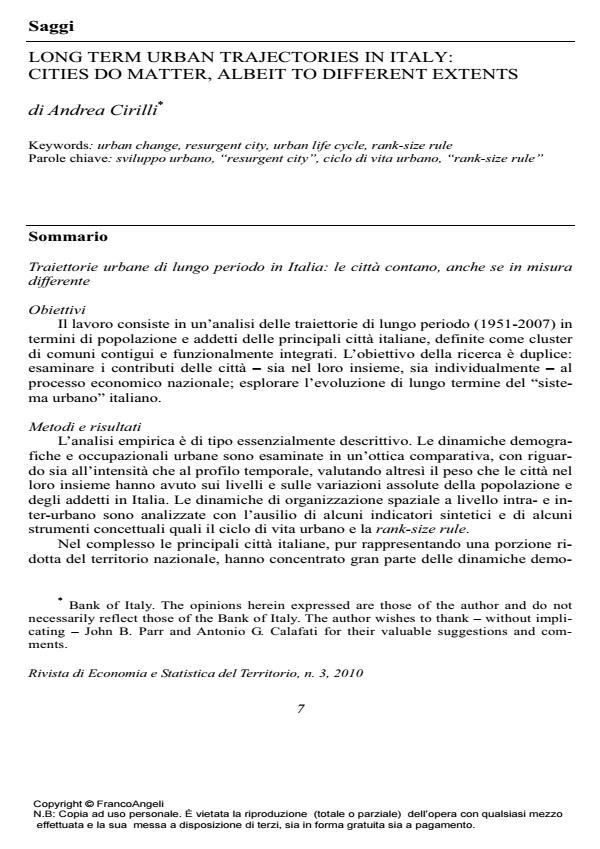Long Term urban trajectories in Italy: cities do matter, albeit to different extents
Journal title RIVISTA DI ECONOMIA E STATISTICA DEL TERRITORIO
Author/s Andrea Cirilli
Publishing Year 2010 Issue 2010/3
Language English Pages 41 P. 7-47 File size 436 KB
DOI 10.3280/REST2010-003002
DOI is like a bar code for intellectual property: to have more infomation
click here
Below, you can see the article first page
If you want to buy this article in PDF format, you can do it, following the instructions to buy download credits

FrancoAngeli is member of Publishers International Linking Association, Inc (PILA), a not-for-profit association which run the CrossRef service enabling links to and from online scholarly content.
This work consists in a long term (1951-2007) analysis of population and employment trajectories of the major Italian cities, the latter being interpreted as clusters of contiguous and functionally integrated municipalities. The aim of this research is twofold: to assess the contribution that cities - both in the aggregate and individually - have made to the national economic process; to explore the long run spatial evolution of the Italian urban system. A few relevant stylised facts have been found. First of all, the selected cities, despite representing a minor proportion of the Italian territory, have accounted for the bulk of the national population and employment dynamics, with some differences arising in terms of geographic macro-areas. Secondly, Italian urban trajectories have widely differed both in intensity and in time patterns. This suggests that the different cities have made and may make different contributions to national economic development, hence their growth potential and peculiar role should be appropriately gauged by policy-makers on formulating regional development policies. Thirdly, there is no unambiguous evidence of either a revival or a decline of cities in Italy in the recent past, although cities - especially the relatively smaller - have been gaining more importance in the last years. From a spatial point of view, the Italian urban system has experienced a significant process of concentration both at the intraand inter-urban level from the Fifties to the Seventies of the last century, mainly due to a rapidly industrialising economy. Nevertheless, a variety of urban spatial patterns have emerged, with the core municipalities - within the cities - and the relatively larger cities - relative to the whole urban system - playing different roles in the different time periods.
Jel codes: R11, R12
- Are medium-sized cities strong nodes in the settlement system? Demographic trends of Italian provincial capitals from 2000 to the Covid-19 pandemic Maria Antonietta Clerici, in Geographia Polonica /2023 pp.347
DOI: 10.7163/GPol.0240
Andrea Cirilli, Long Term urban trajectories in Italy: cities do matter, albeit to different extents in "RIVISTA DI ECONOMIA E STATISTICA DEL TERRITORIO" 3/2010, pp 7-47, DOI: 10.3280/REST2010-003002